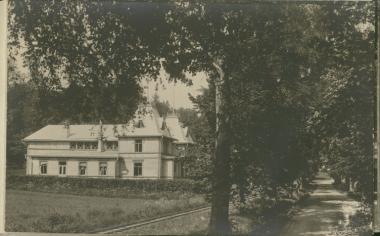The Fiskars Assembly Hall 1896-2011
In the late 1800s, Fiskars was a very culturally active place. Different associations in the Ironworks were however in need of proper facilities where the members could get together. The only place available was a small, cramped space in the villager’s laundry room, and this space was utilized by the marching band, the choir, theatre groups and lecturers among others.
The initiator Karin von Julin
Karin von Julin (1871-1914), oldest daughter of the first director of the Fiskars corporation Albert von Julin, had known for a long time that the lack of proper facilities was slowing down the cultural development of the Ironworks. On September the 24th in 1895, she initiated a share subscription for a “recreational assembly hall”. The equity capital was placed at 10 000 Finnish marks, but it generated only 2700 marks. The subscribers consisted mostly of von Julin family members and other Ironworks officials. Other subscribers were high ranking officials such as Wilhelm Brummer and Leo Mechelin. The Fiskars corporation had reserved 12 000 marks for the Assembly Hall in their budget for 1895. Until the year 1900, the corporation also reserved 2000 marks annually for the building and its reading room, which functioned from 1897 to 1938.

An architect is hired
Fiskars resident Waldemar Aspelin, son of former director J.W. Aspelin, was hired as the architect for the project. The blueprints arrived by mail on the 3rd of March 1896, and the name of the Assembly Hall, “Samlingslokalen” was established. Construction of the Renaissance Revival-style building lasted seven months and was supervised by construction foreman Johannes Wiklund. Pleased with the new premises, Karin treated the construction foreman to coffee and wine at the final inspection on the 9th of October 1896.
A place for everyone
At the opening ceremony of the Assembly Hall on the 8th of November 1896, the play “A midsummer’s night in Dalarna” was performed. The opening celebrations ended with a dance at 10 in the evening.
Due to both local and traveling theatre groups, theatre remained popular in Fiskars until the late 1940s. In addition to plays, there was also singing, dancing, musical performances, gymnastics, and courses and lectures concerning different topics in the Assembly Hall. The grand piano that Karin von Julin had donated was also in active use.
Many traditions were born in the Assembly Hall and many celebrations and festivities were held here, such as the fire brigade’s Boxing Day dance, the local choir’s New Year’s Eve party, I.A. von Julin’s Epiphany celebration for the fire brigade, trophy ceremonies for the local sports association, dances, after skiing events, the tennis club’s dinners on 31st of April, and Mother’s Day celebrations. Many couples have met and later celebrated their wedding at the Assembly Hall.
Repairs and improvements
Electricity was installed in the Assembly Hall when it was first built. Since then, the building has gone through many repairs and renovations. In 1920, the timber walls were boarded both on the inside and the outside, and the main hall was painted blue and red.

Lennart Segerstråle’s paintings decorated the walls
In 1938, water- and sewer pipes were installed along with central heating, and the walls of the main hall were painted in a lighter color. A café- and kitchen space was built where the guest rooms had been located, and dressing rooms for the performers were built behind the stage. This year the Fiskars company also commissioned Lennart Segerstråle to paint monumental paintings to decorate the walls of the main hall. Their reveal was held on the 14th of December, 1938.

The movie theater
In 1947, the Assembly Hall received equipment for showing movies, which were shown regularly until the 1970s. Next, the stage was expanded and the janitor’s apartment was modernized. The outside walls of the building were painted in 1983. Several repairs were made in 1995 in preparation for the 100th anniversary of the Assembly Hall. Segerstråle’s paintings were restored, the banquet hall was repainted, lighting in the main hall was renewed, new toilets were built, and the kitchen- and café spaces were refurbished.
The Assembly Hall in the 21st century
Thanks to the Fiskars Local History Society, who rented the Assembly Hall from 1978-2009, the building has retained its original purpose up to this day. In 2010, the two rooms behind the stage originally used as dressing rooms for actors were remade into rented rooms. The rooms contain their own utility kitchens, and a shared bathroom. Thus, the Assembly Hall regained its guest rooms. Modern technology for using the space as a conference center was also installed in the main hall. In 2011, the Finnish Gastronomy Academy moved into the janitor’s apartment, where cooking classes were held by chef Markus Aremo. From 2013 to 2015 the apartment housed a separate space for restaurant Wärdshuset, and in the summer of 2015 the kitchen- and café side housed the Japanese restaurant Kitamura. During the summer of 2016, the other side of the building housed a restaurant called Lukaali. The interior surfaces and toilets were all renovated in 2016. The Assembly Hall can also be booked for parties and other events.
The museum’s collections also contain many different objects and pictures related to the history of the Assembly Hall, such as stage props and costumes, pictures of different celebrations and events such as gymnastics practices, movie posters and Lennar Segerstråle’s watercolor sketches. Some of these items are on display in the museum’s exhibition “Life at the Fiskars Ironworks”.
Text: Fiskars Museum 2017
